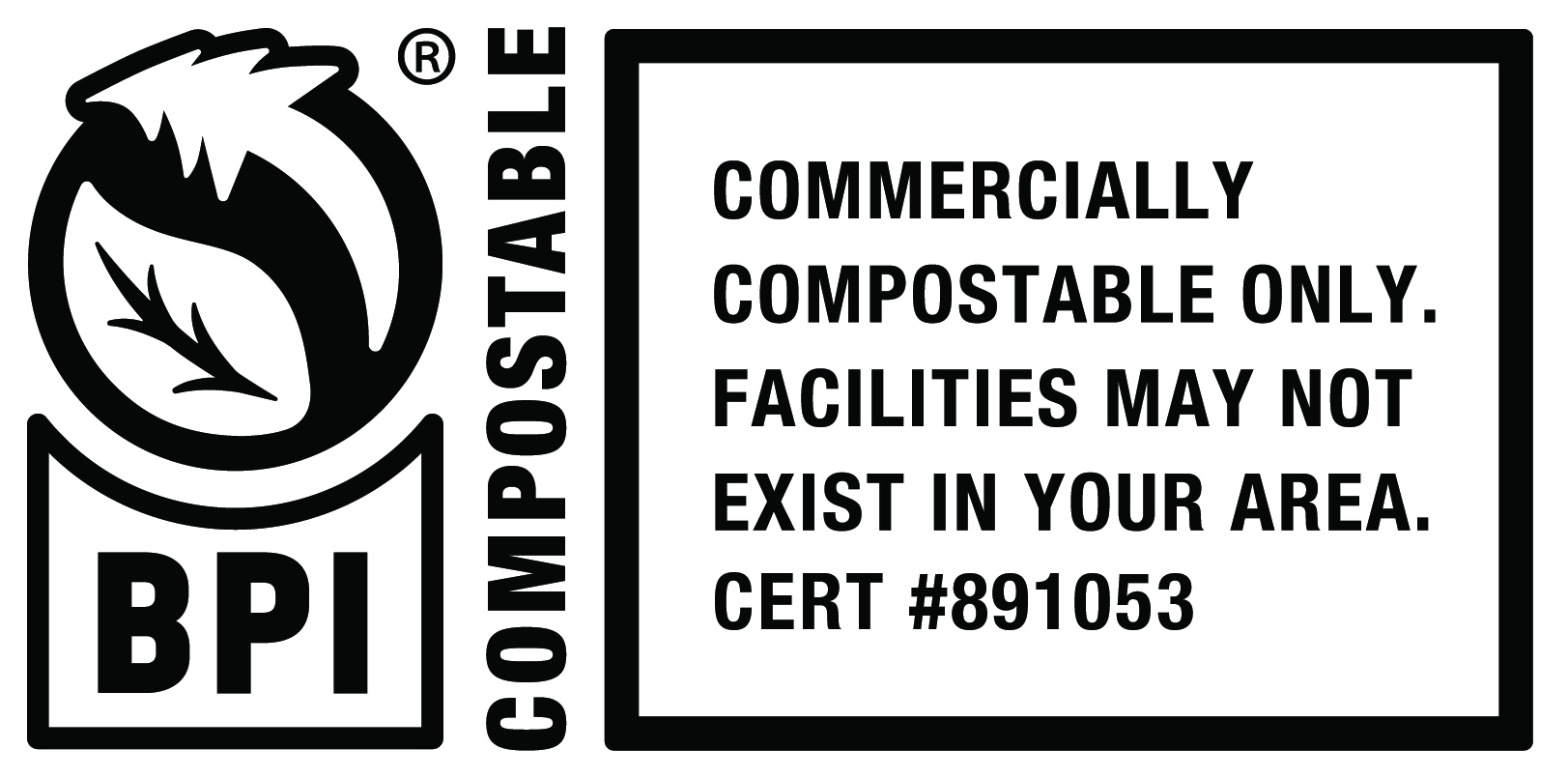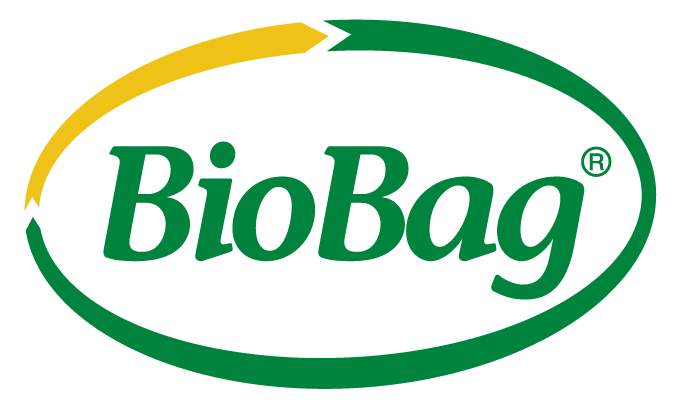Biodegradable and compostable are terms used when describing organic materials breaking down in a specific environment. Both terms are often used when defining environmentally friendly products. The term biodegradable is very often misused in marketing and advertising of products and materials that are not actually environmentally friendly. (The State of California outlawed the use of the terms “biodegradable,” “degradable,” or “decomposable,” or any form of those terms because of all the abuse and greenwashing. See more.) This is why BioBag® Americas only uses the term “Compostable” when describing, marketing, and labeling our products. All of BioBag’s products are third-party certified compostable. You can see our certifications here.
Biodegradable
The definition of biodegradable is that a material is capable of undergoing biological anaerobic or aerobic degradation leading to the production of CO2, H2O, methane, biomass, and mineral salts, depending on the environmental conditions of the process. An important role in biodegradation is played by microorganisms, which are present in the environment and fed mostly by organic waste. However, unlike compostable, the term biodegradable means very little as everything is biodegradable given time. Thus, it is very important to specify the environment where biodegradation is intended to take place.
Compostable
Composting is the process of breaking down organic waste by microbial digestion to create compost. Compost has many beneficial uses including improving and fertilizing soil. To go through a composting process, organic waste requires the right level of heat, water, and oxygen. In a pile of organic waste, there are millions of tiny microbes that consume the waste, transforming the organic materials into compost. In order to claim that a product is fully compostable, the product has to meet all the requirements in the European Norm EN 13432 and/or the US Standard ASTM D6400. Both specifications require that biodegradable/compostable products completely decompose in a composting setting in a specific time frame, leaving no harmful residues behind. All of BioBag products (except the Max Air bucket) meet the requirements of the US Standard ASTM D6400 and the European Norm EN 13432.
Oxo-degradable
In this section we also wanted to address and define the term, “Oxo-degradable.” Many plastic products that DO NOT and CAN NOT meet the compostability standards have labeled themselves Oxo-Degradable. These plastics are mainly based on polyethylene and contain additives that cause the plastic to degrade. The additives are typically organic compounds of transition metals (such as cobalt, iron, nickel, and manganese).
More specifically, Oxidative degradation is a complex series of chemical reactions in which the long chains of polyethylene molecules are broken down into shorter lengths by the action of oxygen, ultra-violet light and/or heat. This degradation process causes deterioration in the strength of the plastic, which becomes brittle and easily fragments into small pieces. “Fragment” is the key here. The fate of plastic fragments that remain in the soil is an area of uncertainty. Although these are regarded as beneficial by the producers, concerns have been raised that these particles of plastic may be ingested by invertebrates, birds, animals or fish. Additionally, one should also should be quite suspicious of any manufacturer making claims that their products will degrade in an air-locked landfill, which is absent of oxygen and ultra-violet light. The majority of landfills in the U.S. are anaerobic (air-locked) landfills.
Again, Oxo-degradable plastics are not compostable, according to established international standards EN13432 and ASTM 6400. Oxo-degradable plastics should not be included in waste going for composting, because the plastic fragments remaining after the composting process might adversely affect the quality and saleability of the compost.
Also, Oxo-degradable plastics are not suitable for recycling with main-stream plastics as they have an adverse effect on the quality and usability of the finished recycled product.
To be perfectly clear…BioBags are NOT Oxo-degradable plastics.
To learn more about oxo-degradability and plastics, see this Environmental Impacts of Oxo-degradable study here. There are many more resources on the internet regarding this topic as well. Please call us with any questions about the differences between Compostable BioBags and Oxo-degradable bags.
US Standards
BPI Certification – ASTM D6400

BioBag products are BPI certified to meet the ASTM D6400 specification. When it comes to making marketing claims regarding a product’s biodegradable or compostable attributes, the ASTM D6400 is the industry’s gold standard. The ASTM D6400 is the North American equivalent of the European EN 13432. Both specifications require that biodegradable/compostable products completely decompose in a composting setting in a specific time frame, leaving no harmful residues behind.
It is important to note that the ASTM D6400 is an ASTM specification, meaning specific results must be attained to receive certification. Some manufacturers, who have not met the ASTM D6400 specification, may reference other ASTM standards to promote their products. Usually, these companies will reference the ASTM 6954 or the ISO 14855 as proof that they have surpassed some standard for biodegradation. In fact, the ASTM 6954 and the ISO 14855 are standard procedures to be followed for conducting tests and have no pass/fail requirements for heavy metal content or a product’s ability to disintegrate.
ASTM D6400 – Standard Specification for Compostable Plastics.
(The following is an excerpt from the actual ASTM D6400. To see the full standard, click here.)
Scope
1.1 This specification covers plastics and products made from plastics that are designed to be composted in municipal and industrial aerobic composting facilities.
1.2 This specification is intended to establish the requirements for labeling of materials and products, including packaging made from plastics, as “compostable in municipal and industrial composting facilities.”
1.3 The properties in this specification are those required to determine if plastics and products made from plastics will compost satisfactorily, including biodegrading at a rate comparable to known compostable materials. Further, the properties in the specification are required to assure that the degradation of these materials will not diminish the value or utility of the compost resulting from the composting process.
Detailed Requirements
6.1 In order to be identified as compostable, products must pass the requirements of 6.2, 6.3, and 6.4 using the appropriate laboratory tests, representative of the conditions found in aerobic composting facilities. Test finished articles and products in the same form as they are intended to be used. For products that are made in multiple thicknesses or densities, such as films, containers and foams, only the thickest or most dense products need to be tested as long as the chemical composition and structure remains otherwise the same. It is assumed that thinner gages and lower densities will also compost satisfactorily. Similarly, if additives are present in test samples that pass testing, lower levels of the same additives are similarly passed.
6.2 Disintegration During Composting:
A plastic product is considered to have demonstrated satisfactory disintegration if after twelve weeks in a controlled composting test, no more than 10 % of its original dry weight remains after sieving on a 2.0-mm sieve. Generate laboratory thermophilic composting conditions by performing Test Method D5338 without CO2 trapping component, or ISO 16929.
6.3 Inherent Biodegradation:
A plastic product must demonstrate a satisfactory rate of biodegradation by achieving one of the following ratios of conversion to carbon dioxide found in 6.3.1 or 6.3.2 within the time periods specified in 6.3.3 or 6.3.4, using Test Method D5338 as outlined in 7.3.1 and 7.3.3 of Guide D6002:
6.3.1 For products consisting of a single polymer (homopolymers or random copolymers), 60 % of the organic carbon must be converted to carbon dioxide by the end of the test period when compared to the positive control.
6.3.1.1 For products consisting of more than one polymer, each individual polymer component, present at more than 1 % concentration, must achieve the 60 % specification for homopolymers, as described in 6.3.1.
6.3.2 For products consisting of more than one polymer (block copolymers, segmented copolymers, blends, or addition of low molecular weight additives), 90 % of the organic carbon must be converted to carbon dioxide by the end of the test period when compared to the positive control.
6.3.3 For materials that are not radiolabeled, the test period shall be no greater than 180 days.
International Standards
In addition to the US Standard ASTM D6400, some countries have their own norms like the European Standard EN 13432, and the Australian norm AS4736 (minimal differences between the norms).
Today, the terms biodegradation, biodegradable materials, compostability etc. are very common, but frequently misused. Consequently, this is a source of misunderstanding. The European Standard EN 13432 “Requirements for packaging recoverable through composting and biodegradation – Test scheme and evaluation criteria for the final acceptance of packaging”, resolves this problem by defining the characteristics that a material must have, in order to be defined as “compostable”, namely that it can be recycled through organic recovery (composting and anaerobic digestion). This standard applies to plastic packaging and lignocellulosic materials. The standard excludes plastic materials not used as packaging, such as plastics used in agriculture or bags for waste collection, which are covered by Standard UNI EN 14995. From a technical perspective it is identical to UNI EN 13432, but it can cover a wider range of applications other than packaging. The technical content of the two standards is identical, meaning that any plastic material that complies with UNI EN 13432 also complies with UNI EN 14995, and vice versa. These standards are the most important technical references for manufacturers of materials, public authorities, composters, certifying bodies and consumers.
According to the European Standard EN 13432, a compostable material must have the following characteristics:
- Biodegradability, which is determined by measuring the actual metabolic conversion of the compostable material into carbon dioxide. This property is quantitatively measured using the standard test method, EN 14046 (which is also published as ISO 14855: biodegradability under controlled composting conditions). The acceptance level is 90%, which must be reached in less than 6 months.
- Disintegrability, that is, the fragmentation and loss of visibility in the final compost (absence of visual contamination). This is measured with a composting test (EN 14045). The test material is degraded, together with organic waste, for 3 months. After this time, the compost is sieved with a 2 mm sieve. The residues of test material with dimensions higher than 2 mm are considered as not having disintegrated. This fraction must be less than 10% of the initial mass.
- Absence of negative effects on the composting process. This is checked with a composting test.
- Low levels of heavy metals (below the predefined maximum values), and absence of negative effects on the quality of the compost (e.g. reduction of the agronomic value and presence of eco-toxicological effects on the growth of plants). A plant growth test (OECD test 208, modified) is carried out on compost samples where the degradation of the test material has taken place. There must be no difference from control compost. Other chemical-physical parameters that must not be different from those of the control compost after the degradation are the pH, salinity, volatile solids, N, P, Mg, K.
- Each of these requirements must be met simultaneously for a material to be defined as compostable. For example, a biodegradable material is not necessarily compostable because it must also break up during one composting cycle. On the other hand, a material that breaks up, over one composting cycle, into microscopic pieces that are not totally biodegradable, is not compostable.
Standard EN 13432 is a harmonized technical standard, meaning it has been published in the Official Gazette of the European Community and must therefore be implemented in Europe by national standardization bodies. In addition, materials that comply with this standard are presumed to comply with European Directive 94/62/EC on packaging and packaging waste.

